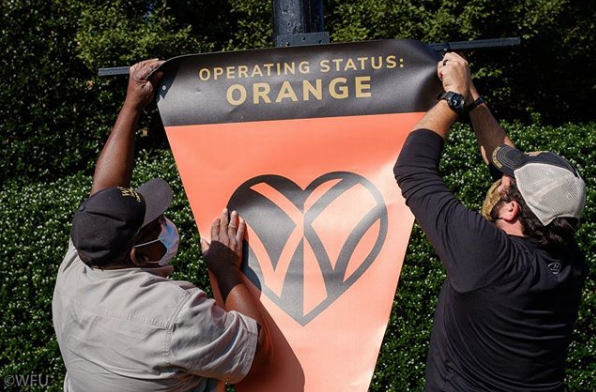Campus COVID-19 cases mirror national trend
As global numbers of COVID-19 cases increase, so do cases on campus

October 29, 2020
Last week, Wake Forest changed its operating status to Orange, meaning that campus is now under stricter COVID-19 guidelines than before. This is the first time the university has tightened restriction since students arrived on campus.
The operating status was changed due to an increase of COVID-19 cases in students on campus — both from asymptomatic, random testing and symptomatic students. The increase of cases on campus is reflective of the national trend as well.
The testing process is twofold; students who have symptoms are urged to quarantine and get tested immediately, while a number of students are randomly chosen each week to participate in a mandatory asymptomatic test.
On Oct. 23, the U.S. reached its highest total number of cases since the pandemic began: 85,085. The total number of cases since the start of the pandemic is now well over 8 million, and the total number of deaths is nearing 228,000.
On campus, there have been 351 reported, confirmed cases since Aug. 17 when school began. However, the vast majority of those cases have occurred in the last month. According to the school’s COVID-19 dashboard, there are currently 169 total known active cases, which is nearly half of all the cases from this entire semester.
For students who were tested diagnostically, meaning they had symptoms, there is a sharp spike in the number of cases in the last month. On Wednesday Oct. 21 alone, there were 32 positive diagnostic tests — this number doesn’t include positives that were found in asymptomatic testing.
Wake Forest is serving as a sort of microcosm for increased cases, as numbers are drastically rising nationally. In a panel discussion with Harvard Medical School, Dr. Anthony Fauci warned that Americans should “hunker down to get through this fall and winter, because it is not going to be easy.”
An article in BBC News suggested that when temperatures drop, people will be more likely to congregate indoors. While being outside has been an essential part of coping with the pandemic, fall and winter temperatures will force people to either be isolated from one another, or to gather in enclosed areas.
As the Center for Disease Control and Prevention (CDC) has reported from nearly the beginning of the pandemic, being within six feet of someone who is infected with the virus increases one’s likelihood of contracting it exponentially.

“Indoor spaces with less ventilation where it might be harder to keep people apart are more risky,” says the CDC website.
When in enclosed spaces, such as dorm rooms or even dining halls, the ability to spread infected droplets goes up, which is also why the orange operating status discourages “indoor sit-down eating,” according to the campus COVID-19 website.
When a person becomes infected with the virus, the incubation period can take anywhere from three to 14 days, according to Harvard Health. However, Harvard Health also reports that those infected with the virus can be contagious anywhere from 48 to 72 hours before they start showing symptoms. This means that someone could be spreading the virus unknowingly for up to three days before they’re aware that they’ve been infected.
The CDC also reports that, while it is not the main way the virus is spread, sharing common surfaces can potentially cause infection. Touching a surface that may have the virus, then your nose, eyes or mouth is potentially dangerous.
As experts are asking Americans to be more vigilant now than ever, the university administration is asking students to do just the same. With the cold and flu season upon us, the pandemic could be even more dangerous than it has been thus far.
In September, CNN published an article that highlighted the complacency of Americans when it comes to COVID-19. The article noted that COVID-19 denialism and President Donald Trump’s persistent message that the pandemic was under control contributed to a lack of serious action being taken among many Americans.
The combination of decreasing temperatures and increasing complacency surrounding COVID-19 action could prove to be deadly. While scientists are still working vigilantly to produce a vaccine, the impetus is still on the American people to continue social distancing, wearing masks and keeping a small bubble.
Now more than ever, nationally and on campus, it is essential that all people are vigilant in their efforts to stop the spread of COVID-19.
“Don’t ever, ever underestimate the potential of the pandemic,” Fauci warned during the panel. “And don’t try and look at the rosy side of things.”











